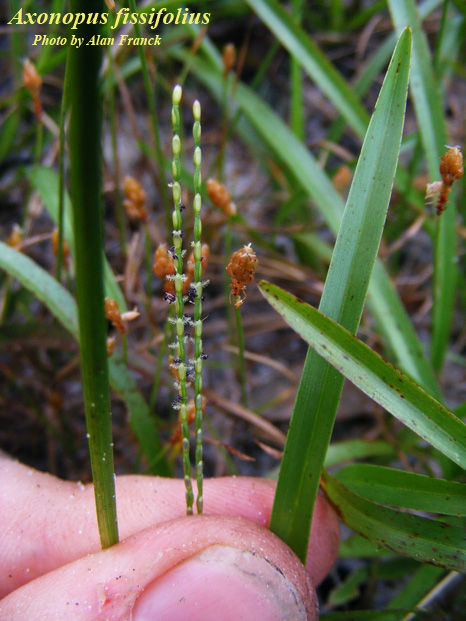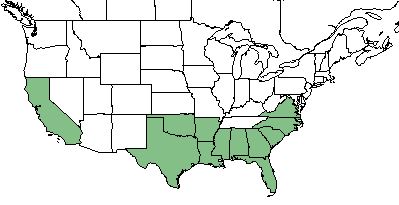Difference between revisions of "Axonopus fissifolius"
(→Ecology) |
|||
| Line 1: | Line 1: | ||
{{italic title}} | {{italic title}} | ||
| − | Common name: | + | Common name: Common Carpetgrass |
<!-- Get the taxonomy information from the NRCS Plants database --> | <!-- Get the taxonomy information from the NRCS Plants database --> | ||
{{taxobox | {{taxobox | ||
Revision as of 19:24, 25 March 2019
Common name: Common Carpetgrass
| Axonopus fissifolius | |
|---|---|

| |
| Photo by the Atlas of Florida Plants Database | |
| Scientific classification | |
| Kingdom: | Plantae |
| Division: | Magnoliophyta - Flowering plants |
| Class: | Liliopsida - Moncots |
| Order: | Cyperales |
| Family: | Poaceae |
| Genus: | Axonopus |
| Species: | A. fissifolius |
| Binomial name | |
| Axonopus fissifolius (Raddi) Kuhlmann | |

| |
| Natural range of Axonopus fissifolius from USDA NRCS Plants Database. | |
Contents
Taxonomic Notes
Synonyms: Paspalum fissifolium Raddi; Axonopus affinis Chase
Varieties: none
Description
A. fissifolius is a perennial graminoid of the Poaceae family, is native to North America and Puerto Rico, and has been introduced to Hawaii. [1]
Distribution
A. fissifolius can be found in the southeastern United States from Texas to Virginia, California, Hawaii, and Puerto Rico. [1]
Ecology
Habitat
A. fissifolius is found in pine flatwoods, sandy forests, fields, roadsides, and lawns. [2] It has also been found in grassland areas with poor drainage, among other bunchgrasses. [3]
Phenology
A. fissifolius occurs more in spots where grazing and trampling were particularly heavy. [4]
Use by animals
A. fissifolius is rated as good forage. [5]
Conservation and Management
A. fissifolius is designated as a weedy or invasive plant by the Hawaiian Ecosystems at Risk Project, Biological Resources Division. [1]
Cultivation and restoration
Photo Gallery
References and notes
- ↑ 1.0 1.1 1.2 USDA Plant Database https://plants.usda.gov/core/profile?symbol=AXFI
- ↑ . Weakley, A. S. (2015). Flora of the Southern and Mid-Atlantic States. Chapel Hill, NC, University of North Carolina Herbarium.
- ↑ Boughton, E., et al. (2013). "Season of fire and nutrient enrichment affect plant community dynamics in subtropical semi-natural grasslands released from agriculture." Biological Conservation 158: 239-247.
- ↑ Lewis, C. E. (1970). "Responses to chopping and rock phosphate on south Florida ranges " Journal of Range Management 23: 276-282.
- ↑ Hilmon, J. B. (1964). "Plants of the Caloosa Experimental Range " U.S. Forest Service Research Paper SE-12